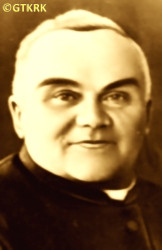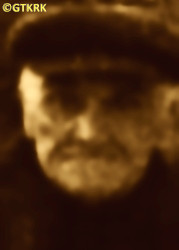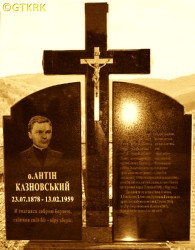Roman Catholic
St Sigismund parish
05-507 Słomczyn
85 Wiślana Str.
Konstancin deanery
Warsaw archdiocese, Poland
full list:
displayClick to display full list

searchClick to search full list by categories
wyświetlKliknij by wyświetlić pełną listę po polsku

szukajKliknij by przeszukać listę wg kategorii po polsku

Martyrology of the clergy — Poland
XX century (1914 – 1989)
personal data
religious status
Servant of God
surname
KAZNOWSKI
surname
versions/aliases
KAZNOWSKIJ
forename(s)
Anthony (pl. Antoni)
function
eparchial priest
creed
Ukrainian Greek Catholic GCmore on
en.wikipedia.org
[access: 2013.05.19]
diocese / province
Stanyslaviv GC eparchymore on
en.wikipedia.org
[access: 2013.05.19]
nationality
Ukrainian
date and place
of death
13.02.1959

Mariupoltoday: Mariupol urban hrom., Mariupol rai., Donetsk obl., Ukraine
more on
en.wikipedia.org
[access: 2022.08.05]
details of death
During Polish–Ukrainian war of 1918‐1919 chaplain of Ukrainian Galician Army UHA.
Thrice arrested by Polish authorities (1919‐interned, c. 1933, 1939).
Three times had his house burnt.
After German and Russian invasion of Poland in 09.1939 and start of the World War II, after start in 1941 of German occupation, arrested in 1943 by the Germans — for publically condemning sending young people for slave labour in Germany.
Sentenced to death but bought out by family.
For a time went into hiding near Buchach.
After the end of military hostilities of the World War II, after start of another Russian occupation, prob. refused to apostatize to Orthodoxy, and after the so‐called pseudo–council in Lviv on 08‐10.03.1946, the incorporation of the Greek Catholic Church into the Orthodox Church and its banning by the Russians, performed secret service among the Greek Catholic believers in the city of Dora.
In 1958 initiated collection of signatures under a petition to re‐register Greek Catholic Church.
Promptly arrested by the Russian KGB.
On 25.06.1958 sentenced in Yaremche to a year in prison and 5 years of exile.
Transported to Mariupol where soon perished in prison.
cause of death
extermination
perpetrators
Russians
sites and events
Forced exileClick to display the description, Ribbentrop‐MolotovClick to display the description, Pius XI's encyclicalsClick to display the description, Polish‐Ukrainian war of 1918‐1919Click to display the description
date and place
of birth
23.07.1878

Hai‐Baryskytoday: part of Barysh, Buchach urban hrom., Chortkiv rai., Ternopil obl., Ukraine
more on
uk.wikipedia.org
[access: 2023.03.02]
alt. dates and places
of birth
Buchachtoday: Buchach urban hrom., Chortkiv rai., Ternopil obl., Ukraine
more on
en.wikipedia.org
[access: 2020.11.15]
parents
KAZNOWSKI Onuphrius
🞲 ?, ? — 🕆 ?, ?

BARYCKA Caroline
🞲 ?, ? — 🕆 ?, ?
presbyter (holy orders)
ordination
1900

positions held
1946 – 1959
priest — Doratoday: part of Yaremche village, Polyanytsya hrom., Nadvirna rai., Stanislaviv/Ivano‐Frankivsk obl., Ukraine
more on
en.wikipedia.org
[access: 2022.08.05] ⋄ Miracles of the St Michael the Archangel GC parish ⋄ Nadvirnatoday: Nadvirna urban hrom., Nadvirna rai., Stanislaviv/Ivano‐Frankivsk obl., Ukraine
more on
en.wikipedia.org
[access: 2020.11.20] GC deanery — secret ministry
1906 – 1946
parish priest — Hlybochoktoday: Borshchiv urban hrom., Chortkiv rai., Ternopil obl., Ukraine
more on
uk.wikipedia.org
[access: 2023.03.02] ⋄ Nativity of the Blessed Virgin Mary GC parish ⋄ Skala‐Podilskatoday: Skala‐Podilska hrom., Chortkiv rai., Ternopil obl., Ukraine
more on
en.wikipedia.org
[access: 2022.08.05] GC deanery
1918 – 1919
GC military chaplain — Ukrainian Galician Army UHA
1905 – 1906
administrator — Hlybochoktoday: Borshchiv urban hrom., Chortkiv rai., Ternopil obl., Ukraine
more on
uk.wikipedia.org
[access: 2023.03.02] ⋄ Nativity of the Blessed Virgin Mary GC parish ⋄ Skala‐Podilskatoday: Skala‐Podilska hrom., Chortkiv rai., Ternopil obl., Ukraine
more on
en.wikipedia.org
[access: 2022.08.05] GC deanery
1903 – 1905
vicar — Skov'yatyntoday: Borshchiv urban hrom., Chortkiv rai., Ternopil obl., Ukraine
more on
uk.wikipedia.org
[access: 2023.03.02] ⋄ St Michael the Archangel GC parish ⋄ Kudryntsitoday: Melnytsia‐Podilska hrom., Chortkiv rai., Ternopil obl., Ukraine
more on
uk.wikipedia.org
[access: 2022.09.14] GC deanery — also: member of St Peter the Apostle Society
1902 – 1903
vicar — Dzvynyachtoday: Zalishchyky urban hrom., Chortkiv rai., Ternopil obl., Ukraine
more on
uk.wikipedia.org
[access: 2023.03.02] ⋄ Assumption of the Blessed Virgin Mary GC parish ⋄ Zalishchykytoday: Zalishchyky hrom., Chortkiv rai., Ternopil obl., Ukraine
more on
en.wikipedia.org
[access: 2020.11.22] GC deanery
1900 – 1902
vicar — Ozeryanytoday: Buchach urban hrom., Chortkiv rai., Ternopil obl., Ukraine
more on
uk.wikipedia.org
[access: 2022.09.31] ⋄ St Michael the Archangel GC parish ⋄ Buchachtoday: Buchach urban hrom., Chortkiv rai., Ternopil obl., Ukraine
more on
en.wikipedia.org
[access: 2020.11.15] GC deanery
1896 – 1900
student — Lvivtoday: Lviv urban hrom., Lviv rai., Lviv obl., Ukraine
more on
en.wikipedia.org
[access: 2022.01.16] ⋄ Department of Theology, John Casimir University [i.e. clandestine John Casimir University (1941‐1944) / Ivan Franko University (1940‐1941) / John Casimir University (1919‐1939) / Franciscan University (1817‐1918)]
1896 – 1900
student — Lvivtoday: Lviv urban hrom., Lviv rai., Lviv obl., Ukraine
more on
en.wikipedia.org
[access: 2022.01.16] ⋄ philosophy and theology, Greek Catholic Theological Seminary
married — five children
sites and events
descriptions
Forced exile: One of the standard Russian forms of repression. The prisoners were usually taken to a small village in the middle of nowhere — somewhere in Siberia, in far north or far east — dropped out of the train carriage or a cart, left out without means of subsistence or place to live. (more on: en.wikipedia.orgClick to attempt to display webpage
[access: 2014.12.20])
Ribbentrop‐Molotov: Genocidal Russian‐German alliance pact between Russian leader Joseph Stalin and German leader Adolf Hitler signed on 23.08.1939 in Moscow by respective foreign ministers, Mr. Vyacheslav Molotov for Russia and Joachim von Ribbentrop for Germany. The pact sanctioned and was the direct cause of joint Russian and German invasion of Poland and the outbreak of the World War II in 09.1939. In a political sense, the pact was an attempt to restore the status quo ante before 1914, with one exception, namely the „commercial” exchange of the so‐called „Kingdom of Poland”, which in 1914 was part of the Russian Empire, fore Eastern Galicia (today's western Ukraine), in 1914 belonging to the Austro‐Hungarian Empire. Galicia, including Lviv, was to be taken over by the Russians, the „Kingdom of Poland” — under the name of the General Governorate — Germany. The resultant „war was one of the greatest calamities and dramas of humanity in history, for two atheistic and anti‐Christian ideologies — national and international socialism — rejected God and His fifth Decalogue commandment: Thou shall not kill!” (Abp Stanislav Gądecki, 01.09.2019). The decisions taken — backed up by the betrayal of the formal allies of Poland, France and Germany, which on 12.09.1939, at a joint conference in Abbeville, decided not to provide aid to attacked Poland and not to take military action against Germany (a clear breach of treaty obligations with Poland) — were on 28.09.1939 slightly altered and made more precise when a treaty on „German‐Russian boundaries and friendship” was agreed by the same murderous signatories. One of its findings was establishment of spheres of influence in Central and Eastern Europe and in consequence IV partition of Poland. In one of its secret annexes agreed, that: „the Signatories will not tolerate on its respective territories any Polish propaganda that affects the territory of the other Side. On their respective territories they will suppress all such propaganda and inform each other of the measures taken to accomplish it”. The agreements resulted in a series of meeting between two genocidal organization representing both sides — German Gestapo and Russian NKVD when coordination of efforts to exterminate Polish intelligentsia and Polish leading classes (in Germany called «Intelligenzaktion», in Russia took the form of Katyń massacres) where discussed. Resulted in deaths of hundreds of thousands of Polish intelligentsia, including thousands of priests presented here, and tens of millions of ordinary people,. The results of this Russian‐German pact lasted till 1989 and are still in evidence even today. (more on: en.wikipedia.orgClick to attempt to display webpage
[access: 2015.09.30])
Pius XI's encyclicals: Facing the creation of two totalitarian systems in Europe, which seemed to compete with each other, though there were more similarities than contradictions between them, Pope Pius XI issued in 03.1937 (within 5 days) two encyclicals. In the „Mit brennender Sorge” (Eng. „With Burning Concern”) published on 14.03.1938, condemned the national socialism prevailing in Germany. The Pope wrote: „Whoever, following the old Germanic‐pre‐Christian beliefs, puts various impersonal fate in the place of a personal God, denies the wisdom of God and Providence […], whoever exalts earthly values: race or nation, or state, or state system, representatives of state power or other fundamental values of human society, […] and makes them the highest standard of all values, including religious ones, and idolizes them, this one […] is far from true faith in God and from a worldview corresponding to such faith”. On 19.03.1937, published „Divini Redemptoris” (Eng. „Divine Redeemer”), in which criticized Russian communism, dialectical materialism and the class struggle theory. The Pope wrote: „Communism deprives man of freedom, and therefore the spiritual basis of all life norms. It deprives the human person of all his dignity and any moral support with which he could resist the onslaught of blind passions […] This is the new gospel that Bolshevik and godless communism preaches as a message of salvation and redemption of humanity”… Pius XI demanded that the established human law be subjected to the natural law of God , recommended the implementation of the ideal of a Christian state and society, and called on Catholics to resist. Two years later, National Socialist Germany and Communist Russia came together and started World War II. (more on: www.vatican.vaClick to attempt to display webpage
[access: 2023.05.28], www.vatican.vaClick to attempt to display webpage
[access: 2023.05.28])
Polish‐Ukrainian war of 1918‐1919: One of the wars for borders of the newly reborn Poland. At the end of 1918 on the former Austro‐Hungarian empire’s territory, based on the Ukrainian military units of the former Austro‐Hungarian army, Ukrainians waged war against Poland. In particular attempted to create foundation of an independent state and attacked Lviv. Thanks to heroic stance of Lviv inhabitants, in particular young generation of Poles — called since then Lviv eaglets — the city was recaptured by Poles and for a number of months successfully defended against furious Ukrainian attacks. In 1919 Poland — its newly created army — pushed Ukrainian forces far to the east and south, regaining control over its territory. (more on: en.wikipedia.orgClick to attempt to display webpage
[access: 2017.05.20])
sources
personal:
newsaints.faithweb.comClick to attempt to display webpage
[access: 2014.03.21], kolomyya.orgClick to attempt to display webpage
[access: 2014.09.21], uk.wikipedia.orgClick to attempt to display webpage
[access: 2019.12.26], missiopc.blogspot.comClick to attempt to display webpage
[access: 2014.09.21], magazine.lds.lviv.uaClick to attempt to display webpage
[access: 2014.03.21], uk.rodovid.orgClick to attempt to display webpage
[access: 2023.11.24], vilne.org.uaClick to attempt to display webpage
[access: 2019.12.26]
original images:
kolomyya.orgClick to attempt to display webpage
[access: 2014.09.21], www.religstud.chnu.edu.uaClick to attempt to display webpage
[access: 2014.09.21], varianty.lviv.uaClick to attempt to display webpage
[access: 2019.12.26]
LETTER to CUSTODIAN/ADMINISTRATOR
If you have an Email client on your communicator/computer — such as Mozilla Thunderbird, Windows Mail or Microsoft Outlook, described at WikipediaPatrz:
en.wikipedia.org, among others — try the link below, please:
LETTER to CUSTODIAN/ADMINISTRATORClick and try to call your own Email client
If however you do not run such a client or the above link is not active please send an email to the Custodian/Administrator using your account — in your customary email/correspondence engine — at the following address:

giving the following as the subject:
MARTYROLOGY: KAZNOWSKI Anthony
To return to the biography press below:
 Click to return to biography
Click to return to biography










